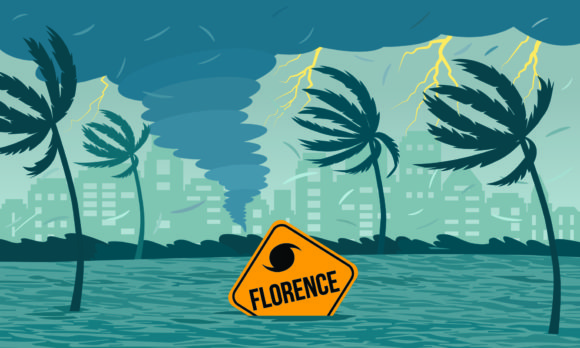Hurricane Florence killed 22 people across three Southeastern states, was the ninth most destructive storm in terms of property damage in U.S. history and spawned 44 tornadoes, according to a report from the National Hurricane Center.
The report described Florence as “a long-lived, category 4 hurricane” which was named on Aug. 31 and lingered until Sept. 17. The hurricane made landfall along the southeastern coast of North Carolina as a Category 1 storm.
Fifteen people were killed in North Carolina, the report said, with 11 of those dying because of flooding. Four people were killed by floods in South Carolina.
Of the tornadoes caused by Florence, the report said an EF-2 in Chesterfield County, Virginia, on Sept. 17 caused significant structure damage.
In all, Florence made an impact on four states. Damage from Florence was estimated at $24 billion. North Carolina bore the brunt of that total, with an estimated $22 billion in damage. Another $2 billion in damage was recorded in South Carolina and $200 million in Virginia. Florence had weakened significantly and was little more than a tropical storm when it passed near the Georgia border with South Carolina. As a result, damage in Georgia was estimated at $30 million.
According to the report, the storm left 1.1 million residents without power, all but 100,000 in North Carolina.
Among other findings, the report said Florence produced rainfall exceeding 10 inches (25 centimeters) across parts of North Carolina and South Carolina. Some totals exceeded 20 inches (50 centimeters) from the North Carolina-South Carolina border east to southeastern North Carolina. The slow forward speed of the storm created persistent rain bands over the area, leading to almost 36 inches (90 centimeters) of rain near Elizabethtown, shattering the record of 24.06 inches (61.11 centimeters) in Southport during Hurricane Floyd in 1999.
In South Carolina, 23.93 inches (60.78 centimeters) of rain was recorded at Loris, beating the previous record of 17.45 inches (44.32 centimeters) near Lake Jocassee from Tropical Storm Beryl in 1994.
Topics Catastrophe Natural Disasters Windstorm North Carolina Hurricane South Carolina
Was this article valuable?
Here are more articles you may enjoy.



 Marsh McLennan Agency to Buy Fisher Brown Bottrell for About $316M
Marsh McLennan Agency to Buy Fisher Brown Bottrell for About $316M  California Sees Two More Property Insurers Withdraw From Market
California Sees Two More Property Insurers Withdraw From Market  Jury Awards $80M to 3 Former Zurich NA Employees for Wrongful Termination
Jury Awards $80M to 3 Former Zurich NA Employees for Wrongful Termination  Aon Completes $13B Acquisition of Middle-Market Broker NFP
Aon Completes $13B Acquisition of Middle-Market Broker NFP 


